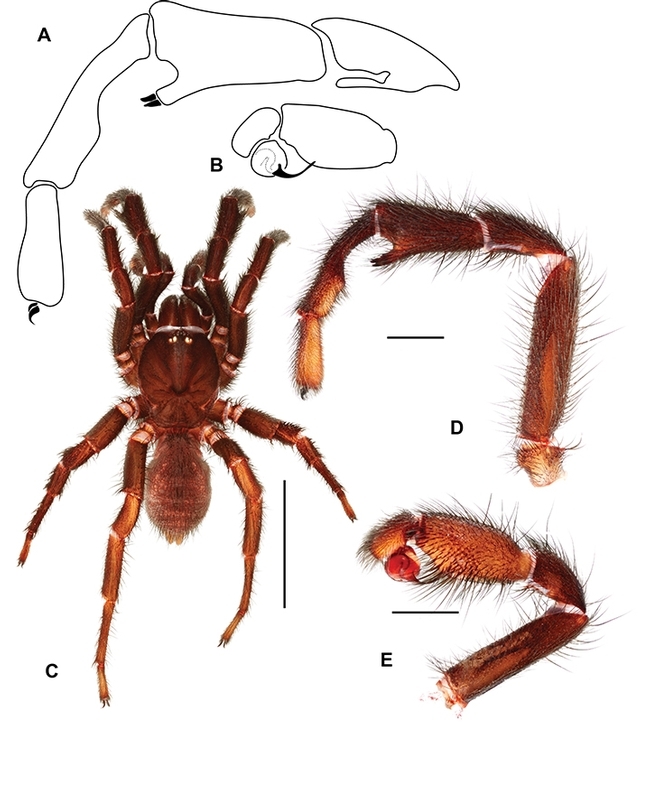
He received more than 200 suggestions.
Bond, a noted spider authority and the Evert and Marion Schlinger Endowed Chair in Insect Systematics, UC Davis Department of Entomology and Nematology, accepted suggestions from mid-May until 5 p.m., June 1.
His colleague, Joel Ledford, assistant professor of teaching, UC Davis Department of Plant Biology--his research interests include spider systematics and biology education--interviewed Bond May 18 for his Tree of Life-UC Davis YouTube channel. See the episode online.
Bond discovered the new genus of trapdoor spiders on a sandy beach at Moss Landing State Park, Monterey County. Bond proposes to name the genus, Cryptocteniza, part of which means “hidden or secret.”
"There were a few distinct categories of name suggestions," said Bond, who received most through his email but some posted on the YouTube Channel. The categories:
- Native American groups and Native American terms
- Moss Landing derivative names – nouns in apposition associated with the type locality
- Names for celebrities or film characters – a modicum of Harry Potter suggestions as well
- Folks wanting me to name the spider after myself or some other association with the Bond name, related to No. 3
- Most recently names related to George Floyd or other associations with the Black Lives Matter movement.
A virtual open house on spiders, hosted by the Bohart Museum of Entomology, UC Davis, will be broadcast on FacebookLive sometime soon, said Tabatha Yang, education and outreach coordinator. It was initially scheduled for June 8 but postponed.
When it is rescheduled, Bond will discuss spiders, field questions about spiders, and list the top suggestions--perhaps several--for the species. When the final decision is made, the person who named it will be included in Bond's upcoming manuscript on the new genus. Ledford is a co-author.
Trapdoor spiders are so named because they construct their burrows with a corklike or wafer trap door made of soil, vegetation and silk.
Bond discovered the female spider in 1997 on the sandy beach, and figured at the time it might be a new genus. But despite repeated trips to the site, he could not find a male for 22 years. The male proved elusive until pitfall trap sampling in the fall of 2019.
“I have only one male specimen,” Bond told Ledford. He said he will be “relieved” when it is described and finds a home in the Bohart Museum of Entomology, located in Room 1124 of the Academic Surge Building on Crocker Lane. (It is temporarily closed due the coronavirus pandemic precautions.)
“This genus meets the criteria of an endangered living fossil,” Bond said, “and is consequently of grave conservation concern.” He believes the genus is found only in that area, but thinks it may be closely related to a genus found in New Mexico and Arizona. “It is quite plausible that this genus was once likely far more widespread across California and the American Southwest, with potentially greater past species diversity throughout its larger hypothetical ancestral range,” he said.
Of the genus name, Cryptocteniza, Bond says that the adjective “hidden or secret” is prefixed to Cteniza, the Greek feminine noun “comb.” The latter refers to the comb-like rastellum (row of stiff spines on the chelicera) common in taxa and formerly assigned to the spider family Ctenizidae (e.g., Eucteniza). The prefix refers to both the diminutive form of the rastellum and the seemingly “hidden in plain sight” nature of the genus, he says.
It is rare to find a genus in the field, the professor said. The usual place is in museum collections.
The trapdoor spider family Euctenizidae is comprised of some 76 described species in seven genera widely distributed throughout the United States, although a few species are known from Mexico.
Some of the suggestions posted on YouTube:
- Cryptocteniza 007 since it is hidden in plain sight and your name is Bond.
- Cryptoctenzia quartertine: a combination of “quarter” and “quarantine,” since it took you a quarter of a century to find a male specimen, and because of our current Covid experience!
- Cryptoceniza nutella (for the rich dark brown color)
- Cryptocteniza steinbeckii (for one of Monterey County's most famous residents, though apparently John Steinbeck already has a fish named after him)
- Cryptoceniza pairspinster (paired spinster since the male was found after so many years)
- Cryptoceniza Spidey McSpiderface
Attached Images:

This is male of the species of a new genus of trapdoor spiders that UC Davis professor Jason Bond discovered in Monterey County. Bond proposes to name the genus, Cryptocteniza, part of which means “hidden or secret.” (Image by Jason Bond)

This is where UC Davis professor Jason Bond discovered a new genus of trapdoor spiders. (Illustrations by Jason Bond)